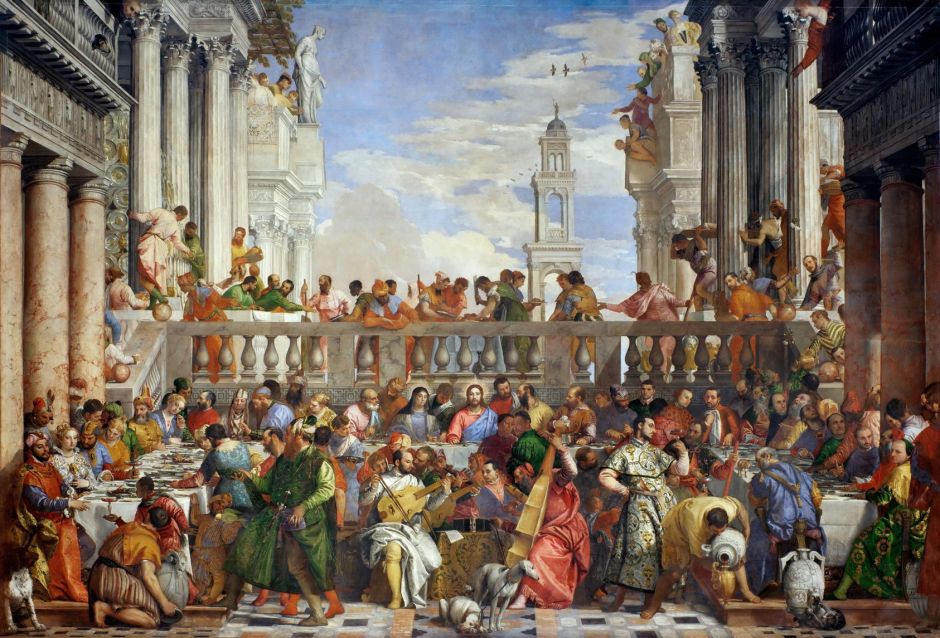In yesterday’s collection of paintings of weddings, I looked at the three weddings of classical myth which brought catastrophe. The good news in the New Testament is that is put behind us, and wedding celebrations needn’t lead to the fall of major city-states like Troy. Instead they form the theme of one of the world’s greatest (in every sense) paintings.
The Marriage Feast at Cana

In 1562, Paolo Veronese was commissioned to paint a large work for the refectory of the Benedictine Monastery of San Giorgio Maggiore in Venice. Its central narrative is an episode of the ministry of Christ as recorded in the gospels: Christ and his disciples were invited to a wedding feast in Cana, Galilee. Towards its end, the wine started to run out, and he was asked what they should do. He directed servants to fill jugs with water, which he then miraculously turned into wine.
The huge canvas shows Christ, distinguished by his halo, at the centre of his disciples, with the Virgin Mary (also with halo) at his right, and sundry disciples arrayed along that side of the tables. The wedding group is at the far left of the party.

At the far right of the canvas, wine is shown being poured from a large container, a clear cue to the gospel narrative.

There is also a great deal of other activity, in every part of the painting. On the balcony behind Christ there are scenes of the butchery of meat, which is generally claimed to be lamb and symbolic of Christ’s future death as a sacrifice for mankind, as the ‘Lamb of God’, although there are no visual clues to support that interpretation.
In the musicians below, and other guests, it is claimed that there are portraits of artists, including Veronese himself, and Titian. Other important figures which are supposed to be shown include Eleanor of Austria, Francis I of France, Mary I of England, Suleiman the Magnificent, and Emperor Charles V.
From about 1856 onwards, the young painter Henri Fantin-Latour copied paintings in the Louvre on commission. Among his best-sellers was Veronese’s Marriage Feast at Cana, of which he made no less than five large-scale copies over a period of eleven years. That seems to have been a successful trade for other painters too: Delacroix had painted at least two slightly modified versions.
Fiction
Weddings played a key role in many popular literary works from the Renaissance onwards. Among the best-known paintings of those are the following.

The eighth story told on the fifth day of Boccaccio’s Decameron concerns the misfortunes of one Nastagio Degli Onesti, which involves one ghost killing and dismembering the ghost of a woman – a strange and grisly tale told in a series of four panels by Botticelli. The fourth and last shows the hero Nastagio’s wedding, the bride and her women sitting to the left, and the men to the right, in formal symmetry. The groom is sat on the other side of the same table as the bride.
The very last story on the tenth and final day of the Decameron is a retelling of the folk story of Griselda, told in the Spalliera Panels in London’s National Gallery, painted in 1494.

The first appears to have been inspired by earlier panels painted by Pesellino, and tells the story of Griselda’s wedding to Gualtieri, using multiplex narrative. At the far left, Gualtieri is hunting prior to his decision to marry. He then sets out on horseback to ride to Griselda’s house. At the right, Griselda is shown naked, as she is just about to be dressed in her fine clothing. In the centre the couple are married.
The marriage of the Christian woman knight Bradamante to the converted knight Ruggiero is the final climax of Ariosto’s epic poem Orlando Furioso.

When their wedding is finally agreed by all parties, a concord which takes hundreds of lines to achieve, King Charlemagne himself takes the lead as if the bride were his own daughter. Paris is then host to a wide range of people, rich and poor, ambassadors and heads of state, for the wedding celebrations.
On the ninth and final day of the wedding celebrations, in the midst of a grand banquet, a knight in a black surcoat rides up and challenges the bridegroom as an apostate. This leads to a final nerve-racking duel between Ruggiero and Rodomonte. In this fresco wall painting by Julius Schnorr von Carolsfeld in the Casa Massimo, Rome, the wedding is shown at the left, and Ruggiero’s earlier baptism on the right.
There are no weddings in Dante’s Divine Comedy, but one he describes in his autobiographical Vita Nuova is of great significance as one of his few encounters with his beloved Beatrice.

Rossetti painted his narrative watercolour of this meeting, Beatrice Meeting Dante at a Marriage Feast, Denies Him Her Salutation in 1852. Dante, dressed in his traditional red, is here being ignored by his beloved, after they bumped into one another at a wedding. This is thought to be Rossetti’s first painting in which he used Elizabeth ‘Lizzie’ Siddall as a model, for Beatrice.
These have all been well-known and, in their own ways, public weddings. Tomorrow I conclude this series about paintings of weddings by looking at some more personal depictions.

